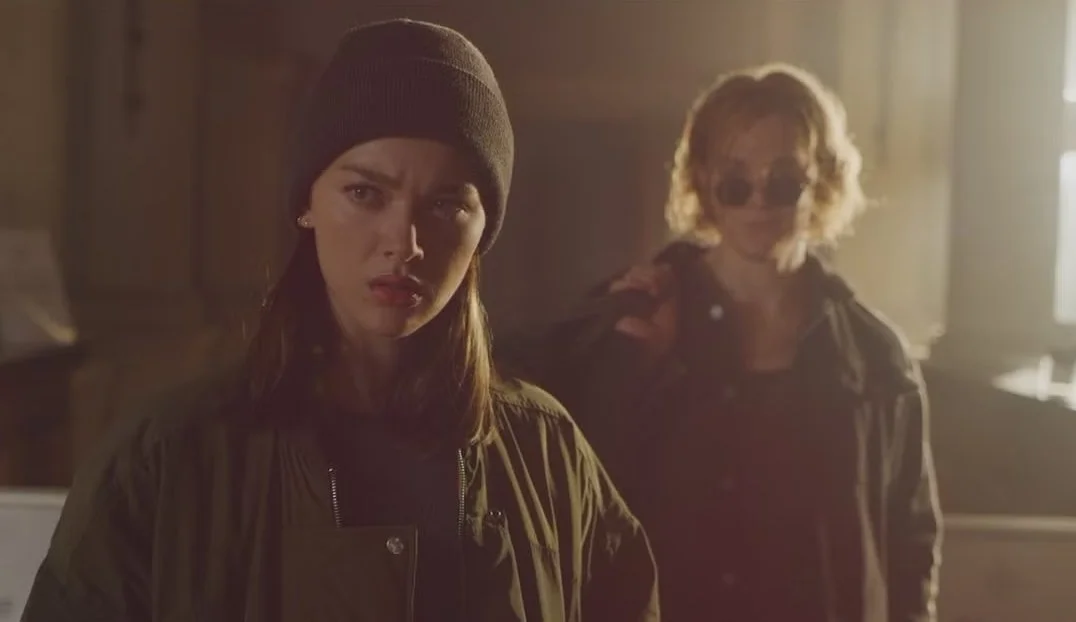Jillian Cheney
Apple TV’s sci-fi drama “Severance” was the most-nominated show at this year’s Emmys — and for good reason. The series boasts a chillingly unique premise: Workers at mega-corporation Lumon have the opportunity to undergo surgery which renders them into two, an “innie” who works from nine to five and an “outie” who lives a regular life outside of work — all to manufacture a twisted work-life balance and preserve confidentiality around work.
(REVIEW) “Fallen,” the love story of a girl loved by a fallen angel, has been adapted to the screen twice since the original book was released in 2009. Its most recent adaptation to television, an eight-episode season now streaming on AMC+, suggests a more negative view of religion that’s developed over the past decade — and it’s worse off narratively for not embracing the original story’s theology.
(REVIEW) If words like “radio silent,” “compound” and “too good to be true” didn’t give it away. In the cult setting, “Opus” explores celebrity worship, creativity, culture as a mouthpiece of movements and the public fascination with true crime. It explains all the reasons why we love consuming cult content — it’s just ultimately an unfulfilling watch on its own.
(REVIEW) The end of winter in New York sometimes feels rife with melancholy. A few spring days taunt with the warmth and new life to come, but the city is still plagued by the dregs of winter. The only appropriate response, if that melancholy has become personal, is to channel that solemn energy into something productive — like going to see the exhibition “The Soul of Nature” at The Metropolitan Museum of Art.
(REVIEW) It appears at first glance that “Heretic” is using religion merely as a springboard for horror, as movies often do. But “Heretic” has much more on offer, making for a surprisingly thoughtful and in-depth study about the nature of religion and faith.
(REVIEW) “Conclave,” the fictional thriller that outlines the Catholic process of selecting a new pope, does the audience the service of stating its intended message outright. In a controversial homily that begins the proceedings, Cardinal Thomas Lawrence declares that “certainty is the great enemy of unity.” The movie also goes on to demonstrate that lesson in a variety of ways, as conspiracy abounds and tension grows.
(REVIEW) Presented as an offbeat rom-com, “Between the Temples” contains a depth of feeling and personal reflection that’s admirable. It’s a must-see for many reasons, and only one of them is its central romance. It’s also a hilarious misadventure, a reflection on life and relationships and the beautiful journey two people take to rediscovering faith.
(REVIEW) Over the past four years, PornHub — one of the most-visited sites on the internet — has faced a reckoning of epic proportions. Efforts spearheaded by sex-trafficking activist Laila Mickelwait are the reason behind this reckoning, recounted in Mickelwait’s new book “Takedown: Inside the Fight to Shut Down PornHub for Child Abuse, Rape and Sex Trafficking.”
(ANALYSIS) Audience members may walk away from the first two movies in the “X” trilogy believing they’re meant to have picked up on a meaning. Maybe something about purity culture, womanhood or aging; maybe a warning about the perils of chasing stardom. But even the intended message is unclear.
Ranjit Singh, known as the “Lion of Punjab,” was responsible for the creation of the Sikh Empire in 19th century north India. A skilled warrior and revered king, as well as the first maharajah of the Sikh people, Singh is one of the most important figures in Sikh history. Now, his life and reign as a ruler are the subject of the exhibition “Ranjit Singh: Sikh, Warrior, King” at London’s The Wallace Collection.
A new dance theater piece brings Sufjan Stevens’ album “Illinois” to life. “Illinoise” is a clever adaptation of Stevens’ work, tying together works that begin with little more in common than a shared theme and similar sound into a seamless narrative. The dance revue includes all the major tracks from the album, though they’re used slightly out of order. None of the characters have speaking roles.
“Immaculate” and “The First Omen” are two horror movies with pregnant nun protagonists in theaters at the same time. It’s admittedly an unusual event. They’re also a veiled response to the overturning of abortion nearly two years ago and the Catholic church’s stance on the issue.
(REVIEW) New horror film “Late Night with the Devil” plays off the fears of the Satanic panic — and exists in a world where those beliefs are all true. The movie is of the found footage genre, a fiction film told with documentary-style footage. It showcases a broadcast and behind the scenes footage from a broadcast of late night talk show “Night Owls” on Halloween of 1977.
(REVIEW) For the past five weekends, the horror movie “Exhuma” has topped box offices in South Korea, its country of origin. This movie, which recently opened in America, is a harrowing must-see. It brings to mind “The Wailing,” a South Korean horror movie from 2016. Both movies wrestle with identity and religion in a variety of ways that also includes a dislike of Japan, a former colonizer, and what it means to be pro-Korean.
There’s no denying the popularity of true crime media in the non-fiction genre. In addition to shows and novels, true crime makes up a massive portion of the podcast market and fuels content creation on social media. Though there are more than a few ethical concerns that come with recounting the most gruesome details of crimes for a rapt audience, demand for this type of content is high — and there’s no shortage of it.
(REVIEW) At the beginning of Dante’s “Divine Comedy,” he describes himself as being in a dark place spiritually. Virgil, the protagonist of the one woman show “Spiritus/Virgil’s Dance,” finds herself in a similar position in the middle of her life: A job she hates, devoid of passion and breaking promises she’d made to herself in youth.
The Grammys, held this year on Feb. 4, are the largest annual awards ceremony held for music. This year, there are no real surprises in the five categories dedicated to Christian and gospel music. Instead, two notable Christian artists with great music have been nominated for some of the top awards of the night.
“Underground,” the Kansas City ballet that tells the story of slaves escaping to freedom through the Underground Railroad, is “not a story of Black versus white, but good versus evil.” The show, which first premiered in 2008 at the Störling Dance Theater, is a beautiful ballet with a strong mission — something this shared sentiment can attest to.
(REVIEW) Famous musician Lil Nas X is making his “comeback” to music — to do it, he’s paying homage to Jesus, “who had the greatest comeback of all time.” The single, “J Christ,” and its music video are saturated with over-the-top, “scandalous” religious images that have generated more than their fair share of controversy.
(ANALYSIS) Modern Christmas movies have become less religious than classics like “A Charlie Brown Christmas” and “It’s a Wonderful Life.” There are several possible reasons for this as America becomes more secular and the holiday’s religious roots give way to other values.
(REVIEW) “The Kingdom, the Power, and the Glory,” a new book written by journalist Tim Alberta, provides an extremely detailed recounting of the past four years in American evangelicalism and how large societal events highlighted the increasing blend of religion and far-right politics.
(REVIEW) There’s a picture-perfect version of Thanksgiving that exists in cartoons of overflowing cornucopias and naively cheerful turkeys. It’s meant to celebrate a bountiful harvest, a good meal and time together with loved ones. The real Thanksgiving is a lot more complicated — and unpleasant. A new movie out now captures just that.
The work of five Ukrainian artists, whose art varies across artistic tradition and highlight the beauty of Ukraine and its people, is currently on view at the Sheen Center’s Janet Hennessey Dilenschneider Gallery. The exhibition, “Beauty During Wartime and Before,” is particularly meant to honor resilience and faith during Russia’s invasion of Ukraine.
The annual celebration of Halloween is marked by fun and frightening traditions, those that involve monsters being the most fun and frightening of them all. These representations of evil are inextricably linked with religion, used to condemn evil, find comfort in suffering and much more.
“(pray)” is a choreopoem that tells a story through the lens of a feminine experience in a Black Baptist Church. It blends the past with the present, the divine with the earthly and the fear of the unknown with the delight of faith.
“Tree & Serpent: Early Buddhist Art in India, 200 BCE–400 CE,” an exhibit at the Metropolitan Museum of Art, explores the influences and growth of early Buddhism through artifacts found largely in southern India. Highlights of the exhibit include relics taken from the Buddha’s remains.
(REVIEW) In the third season of “The Righteous Gemstones,” the fictional Gemstone family members — wealthy leaders of a prominent megachurch — are as outlandish and chaotic as ever. But this season, the challenges they face begin to feel trite and their redemption feels less genuine.
(REVIEW) “The Miracle Club,” about four women from small-town Ireland who make the pilgrimage to Lourdes, is almost a miracle itself. It’s been in the works for nearly two decades and was filmed in only 21 days. Its screenplay is smart and engaging, exploring Christianity, family, confronting the past and womanhood.
(REVIEW) “The Starling Girl” is, at its heart, a visceral reminder of what it’s like to grow up as a girl in strict religious environments. It’s also a thorough picture of the grievances made about fundamentalist and evangelical Christian circles in two recent docuseries.






























(REVIEW) “The Exorcist” has always stuck out to me as a movie because of its universality, its appeal to both the religious and secular. “Exorcistic” is a byproduct of the movie’s lasting influence in media that certainly leaves a wild impression of its own. It’s worth seeing if you want something to put you into the Halloween spirit.